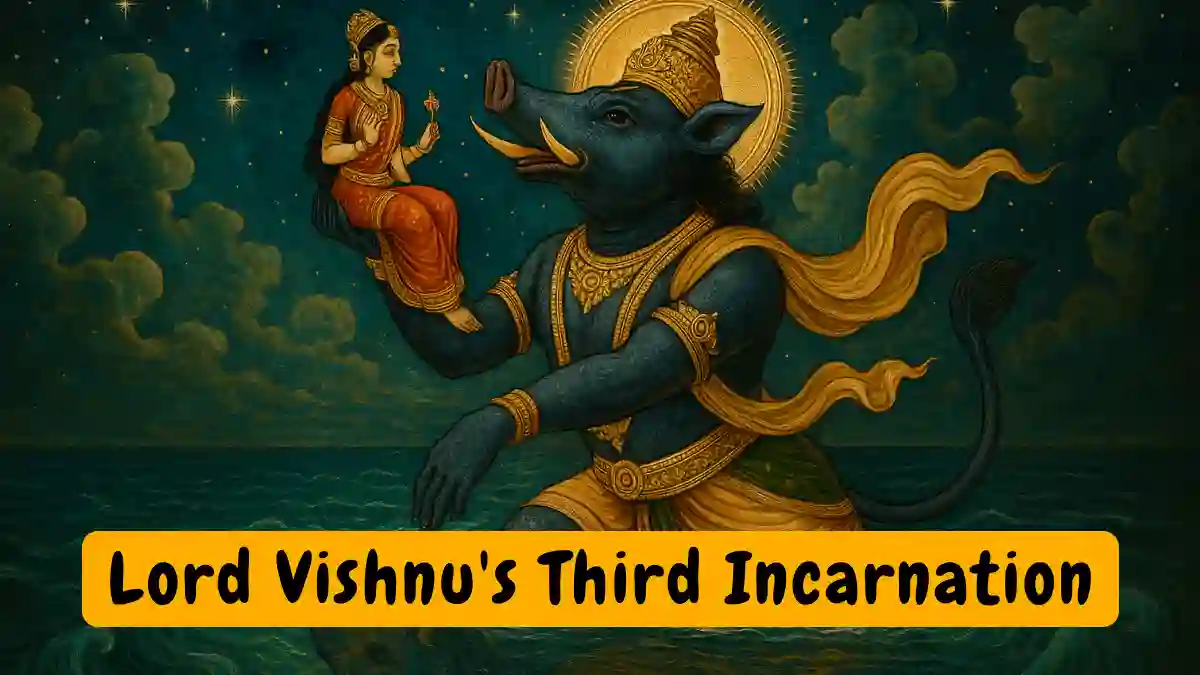Varaha Avatar: The Divine Boar Who Rescued the Earth

Introduction
Among the sacred incarnations of Lord Vishnu, the Varaha Avatar, where He takes the form of a mighty boar, holds deep cosmic and spiritual significance. This divine incarnation is the third among the Dashavatara, the ten principal manifestations of Vishnu, and represents the restoration of dharma (cosmic order) during a time of great turmoil. In this sacred history, the Earth (personified as Goddess Bhudevi) is submerged in the primordial ocean, and Lord Vishnu appears as Varaha to rescue her from the forces of darkness.
This is not just a story of divine intervention—it is a profound event that signifies the triumph of light over darkness, knowledge over ignorance, and order over chaos.
The Fall of the Earth and the Rise of Evil
During the early stages of creation, a powerful asura (demon) named Hiranyaksha, born to the sage Kashyapa and Diti, gained great strength through severe penance and boons from Lord Brahma. Arrogant with power, Hiranyaksha began terrorizing the three worlds. He attacked the celestial realms, defeated the devas (gods), and ultimately plunged Bhudevi, the Earth goddess, into the depths of the cosmic ocean.
With the Earth lost and dharma endangered, the devas and sages turned to Lord Vishnu for help. He assured them that He would descend in a form suitable to restore balance.
The Emergence of Varaha
To the amazement of all celestial beings, Lord Vishnu assumed the form of a gigantic boar—an animal symbolic of strength, fearlessness, and the power to root out evil. The divine boar, known as Varaha, possessed a form as radiant as a thousand suns, and His roar shook the heavens. With eyes glowing like fire and tusks like golden mountains, He plunged into the cosmic ocean in search of Bhudevi.
As He dove deep into the watery abyss, the ocean gods bowed in reverence. Moving swiftly and purposefully, Varaha found the Earth goddess submerged and bound by darkness. With infinite tenderness, He lifted her on His tusks—restoring her to her rightful place in the universe.
The Battle with Hiranyaksha
But the task was not yet complete. As Varaha ascended from the depths with the Earth on His tusks, Hiranyaksha challenged Him to a battle. What followed was an epic confrontation between divine power and demonic arrogance. The two engaged in a fierce combat that shook the very fabric of the cosmos.
In a climactic moment, Lord Varaha, with divine fury, struck down Hiranyaksha with His tusks and hooves, ending his reign of terror. The celestial beings rejoiced, and dharma was restored. Lord Varaha then gently placed Bhudevi back in her orbit, where she could continue nurturing life.
Symbolism and Deeper Meaning
The Varaha Avatar is rich in symbolic meaning and spiritual teachings:
- The Boar: Represents the power of divine will to root out ignorance and restore order. Though a wild creature by form, it is a deliberate and conscious choice of Vishnu to connect with the primal forces of nature.
- The Ocean: Symbolizes the depths of chaos, the subconscious, and the unknown. The descent of Varaha reflects the divine willingness to enter even the darkest realms for the sake of creation.
- Bhudevi on the Tusks: The image of the Earth lifted on Varaha's tusks is one of the most revered symbols in Hindu dharma, depicting the restoration of balance and the protection of nature.
- Battle with Hiranyaksha: Highlights the eternal struggle between righteousness and ego. Even the most powerful evil is ultimately no match for divine truth and courage.
Scriptural References
The sacred history of Varaha Avatar is described in texts like the Bhagavata Purana, Vishnu Purana, and Varaha Purana. In the Bhagavata Purana, Lord Vishnu says:
When the Earth is submerged and the balance is lost, I shall appear as a boar and rescue her with My tusks.
These scriptures honor the Varaha Avatar not only as a divine protector but also as a cosmic restorer who physically and spiritually reestablishes order.
Worship and Temples
The Varaha Avatar is worshipped with great devotion, especially in regions of South India. The Sri Varaha Swamy Temple in Tirumala, Andhra Pradesh, is one of the most famous shrines dedicated to this avatar. It is believed that devotees must first offer their prayers to Varaha Swamy before worshipping Lord Venkateswara.
Other temples such as the Adi Varaha Temple in Mathura and the Varaha Temple in Khajuraho stand as enduring monuments of faith and reverence.
Relevance Today
The teachings of the Varaha Avatar are especially relevant in today's world. With environmental degradation, moral crises, and increasing materialism, the Earth often seems to be metaphorically submerged in chaos. The Varaha Avatar reminds us of the divine commitment to protect and restore—not just the physical Earth but the spiritual harmony of all existence.
It also teaches us the value of courage, action, and reverence for nature. When faced with adversity, we are called to embody Varaha's strength and resolve, and rise with Bhudevi—grounded in dharma, protected by divinity.
Conclusion
The Varaha Avatar stands as a powerful testament to Lord Vishnu's role as the preserver of the cosmos. His divine act of lifting the Earth from the depths of destruction is not just a moment of cosmic heroism—it is a sacred reminder that the divine never abandons creation.
By honoring Varaha, we recognize the need to protect our planet, uphold righteousness, and act with strength and humility in the face of darkness. This sacred event inspires faith that even when the world sinks into despair, the divine will rise—not from the heavens, but from within creation itself—to lift us all back into the light.